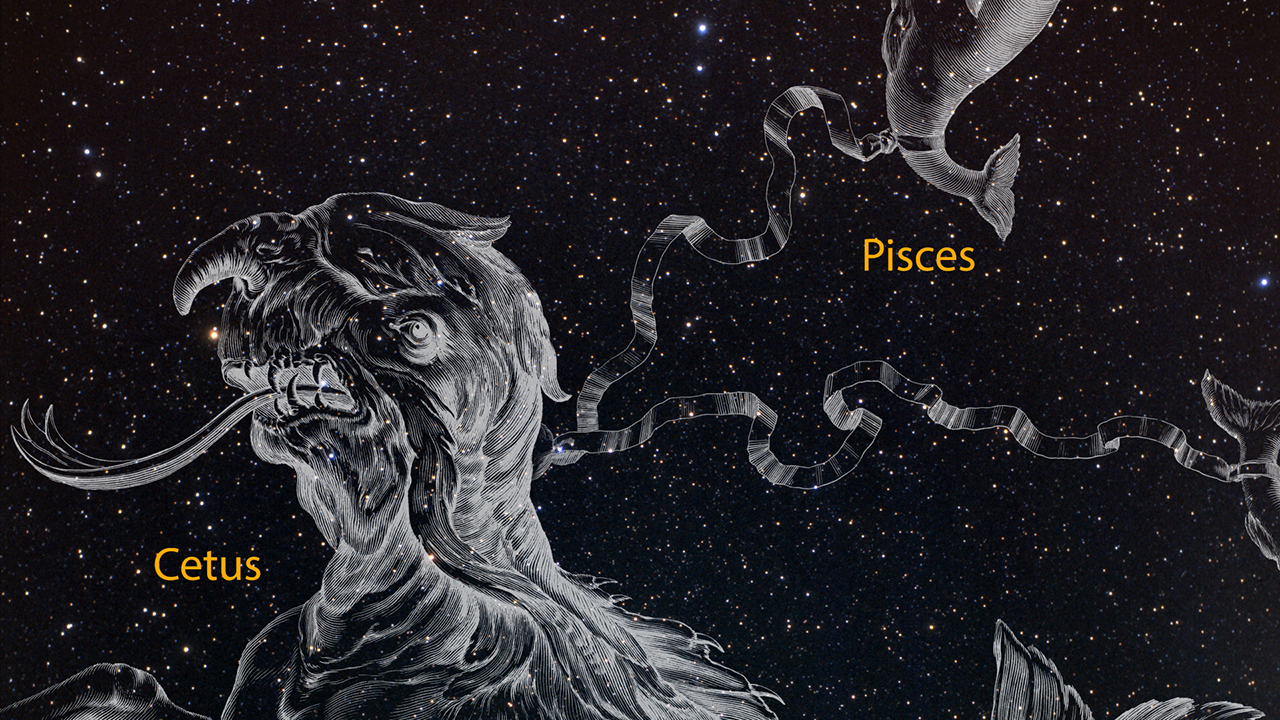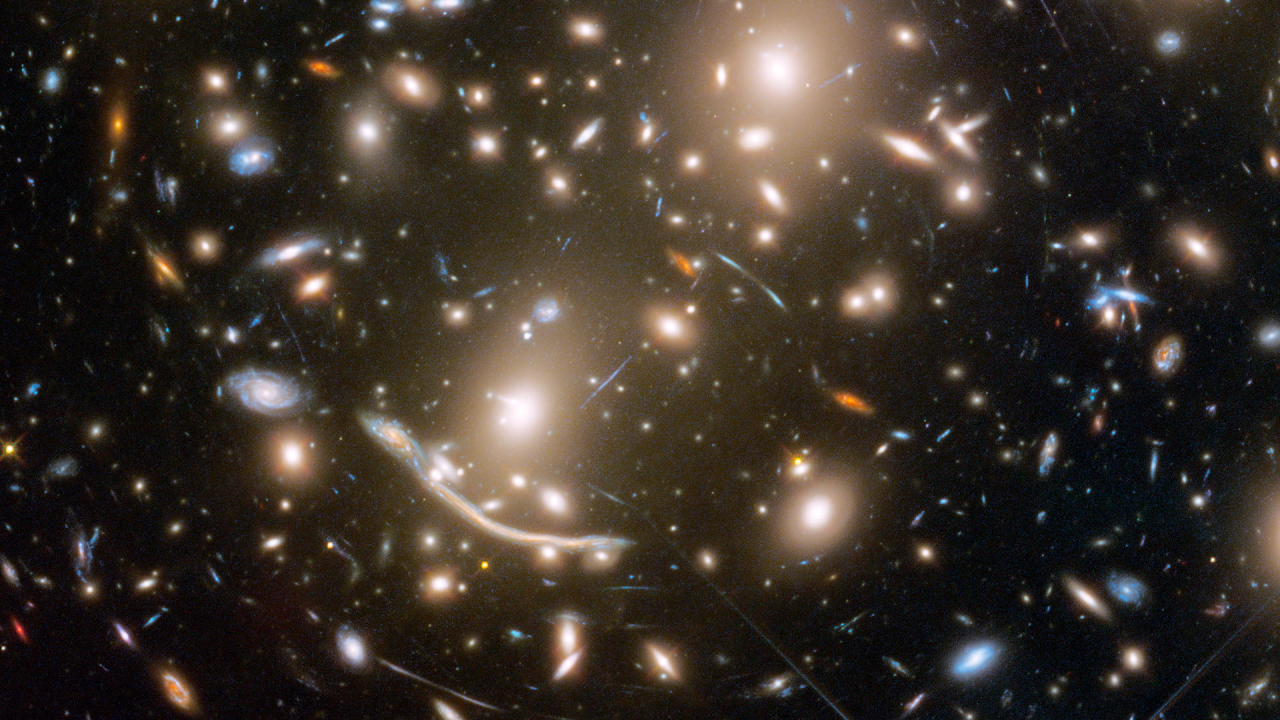1 min read
Abell 370

Much like the eclectic group of space rebels in the upcoming film Guardians of the Galaxy Vol. 2, NASA's Hubble Space Telescope has some amazing superpowers, specifically when it comes to observing innumerable galaxies flung across time and space.
A stunning example is a galaxy cluster called Abell 370 that contains an astounding assortment of several hundred galaxies tied together by the mutual pull of gravity. That's a lot of galaxies to be guarding, and just in this one cluster!
Photographed in a combination of visible and near-infrared light, the immense cluster is a rich mix of galaxy shapes. The brightest and largest galaxies in the cluster are the yellow-white, massive, elliptical galaxies containing many hundreds of billions of stars each. Spiral galaxies — like our Milky Way — have younger populations of stars and are bluish.
Entangled among the galaxies are mysterious-looking arcs of blue light. These are actually distorted images of remote galaxies behind the cluster. These far-flung galaxies are too faint for Hubble to see directly. Instead, the cluster acts as a huge lens in space that magnifies and stretches images of background galaxies like a funhouse mirror. The massive gravitational field of the foreground cluster produces this phenomenon. The collective gravity of all the stars and other matter trapped inside the cluster warps space and affects light traveling through the cluster, toward Earth.
Nearly a hundred distant galaxies have multiple images caused by the lensing effect. The most stunning example is "the Dragon," an extended feature that is probably several duplicated images of a single background spiral galaxy stretched along an arc.
Astronomers chose Abell 370 as a target for Hubble because its gravitational lensing effects can be used for probing remote galaxies that inhabited the early universe.
Abell 370 is located approximately 4 billion light-years away in the constellation Cetus, the Sea Monster. It is the last of six galaxy clusters imaged in the recently concluded Frontier Fields project. This ambitious, community-developed collaboration among NASA's Great Observatories and other telescopes harnessed the power of massive galaxy clusters and probed the earliest stages of galaxy development. The program reveals galaxies that are 10 to 100 times fainter than any previously observed.
About the Object
- ConstellationConstellationOne of 88 recognized regions of the celestial sphere in which the object appears.Cetus
- DistanceDistanceThe physical distance from Earth to the astronomical object. Distances within our solar system are usually measured in Astronomical Units (AU). Distances between stars are usually measured in light-years. Interstellar distances can also be measured in parsecs.4 billion light-years away
About the Data
- Data DescriptionData DescriptionProposal: A description of the observations, their scientific justification, and the links to the data available in the science archive.
Science Team: The astronomers who planned the observations and analyzed the data. "PI" refers to the Principal Investigator.Abell 370 is part of the Frontier Fields Program. These data are from the HST proposals 11108 (PI: E. Hu, University of Hawaii), 11507 (PI: K. Noll, GSFC), 11591 (PI: J.-P. Kneib, Laboratoire d'Astrophysique de Marseille), 13459 (PI: T. Treu, UCLA), 13790 (PI: S. Rodney, JHU), 14038 (PI: J. Lotz, STScI), and 14216 (R. Kirshner, Harvard University). For more information, see http://www.stsci.edu/hst/campaigns/frontier-fields. - InstrumentInstrumentThe science instrument used to produce the data.HST>ACS/WFC and HST>WFC3/IR
- Exposure DatesExposure DatesThe date(s) that the telescope made its observations and the total exposure time.September 2009 - February 2015
- FiltersFiltersThe camera filters that were used in the science observations.ACS/WFC: F435W, F606W, and F814W; WFC3/IR: F105W, F125W, F140W, and F160W
- Object NameObject NameA name or catalog number that astronomers use to identify an astronomical object.Abell 370
- Object DescriptionObject DescriptionThe type of astronomical object.Galaxy Cluster and Gravitational Lens
- Release DateMay 4, 2017
- Science ReleaseA Lot of Galaxies Need Guarding in This NASA Hubble View
- Credit

Blue: F435W + F606W Green: F814W + F105W Red: F125W + F140W + F160W

Related Images & Videos

Abell 370 Parallel
This is a Hubble Space Telescope view of a random patch of sky that reveals how the universe looks at large: a "wallpaper" of innumerable galaxies spread across space and time. They offer a wide assortment of majestic star cities that vary in age, shape, and stellar populations....

Hubble Space Telescope Frontier Fields and Parallels
This is a gallery of the Hubble Space Telescope Frontier Fields. The top six panels are massive galaxy clusters that act as huge lenses in space, magnifying and stretching images of remote galaxies behind each cluster that are too faint for Hubble to see directly. While one of...

Zoom Into Galaxy Cluster Abell 370
This video begins with an image of the constellation Cetus, the Sea Monster, then zooms into galaxy cluster Abell 370. Located approximately 4 billion light-years away, the immense cluster is a rich mix of galaxy shapes. Arcs of blue light entangled among the galaxies are...
Share
Details
Claire Andreoli
NASA’s Goddard Space Flight Center
Greenbelt, Maryland
claire.andreoli@nasa.gov

































